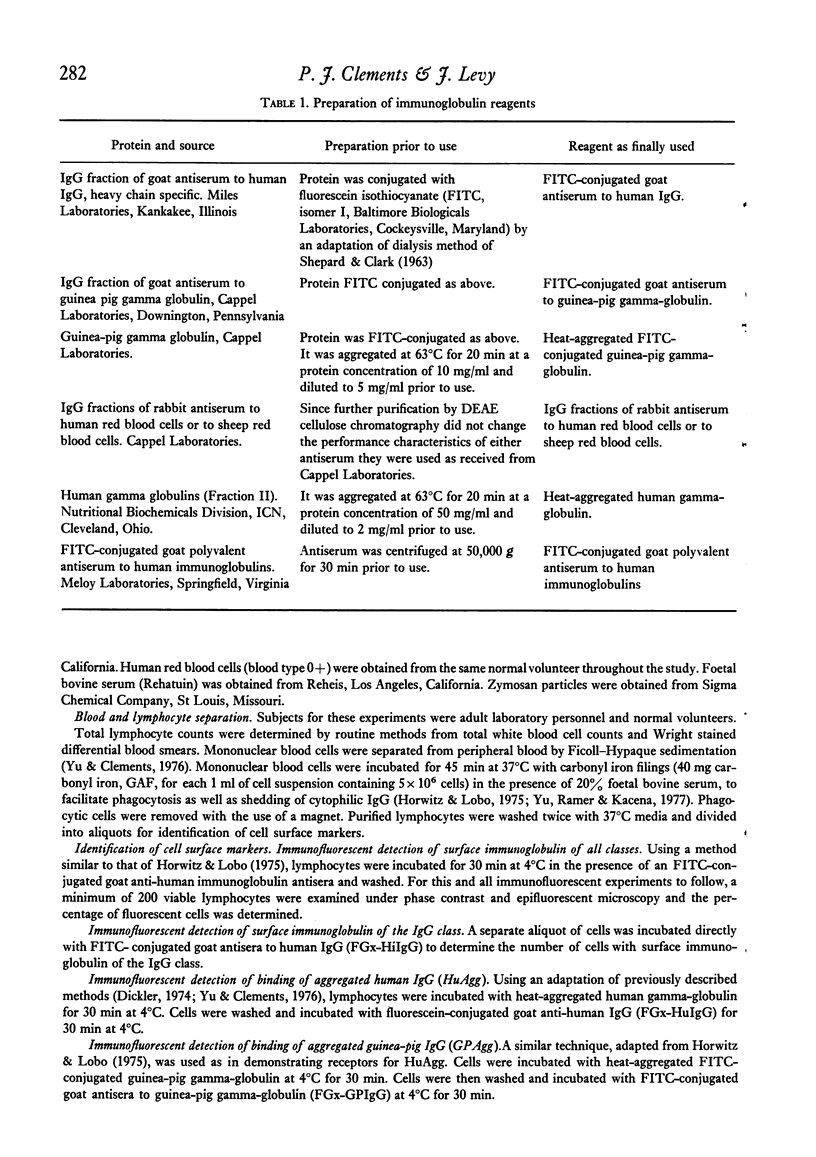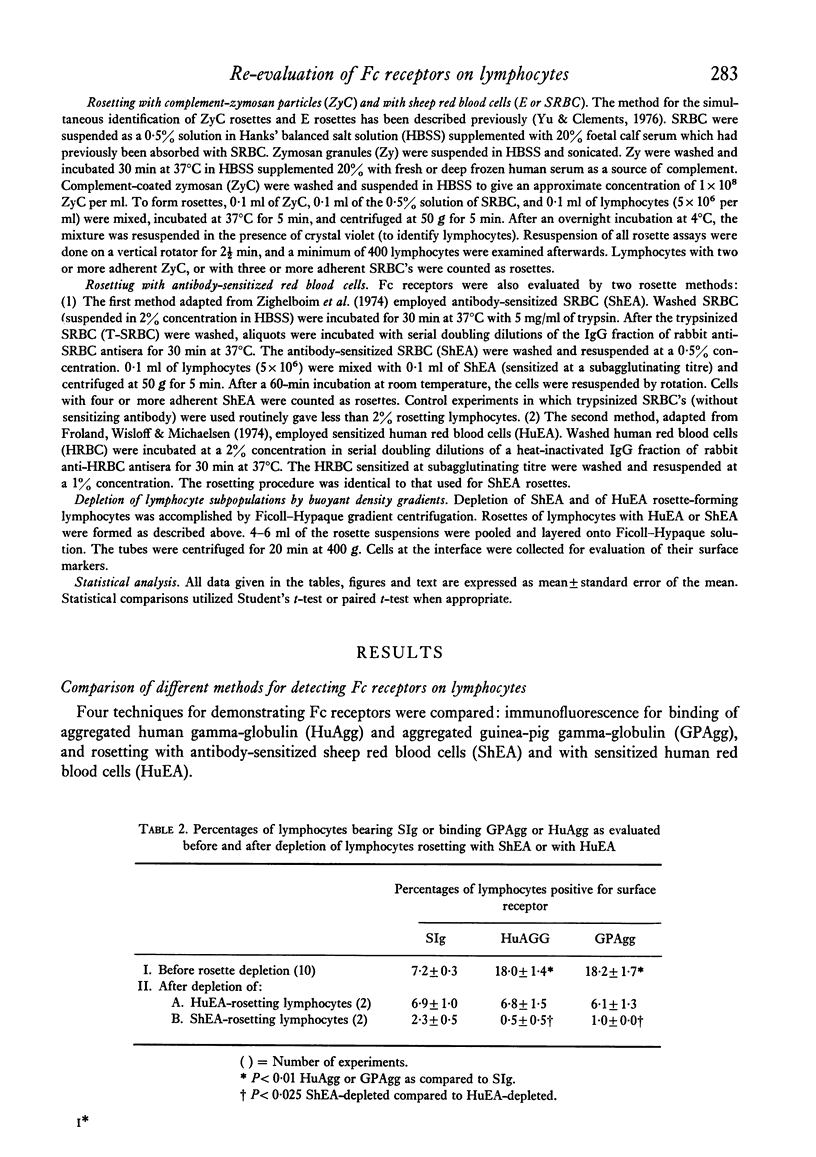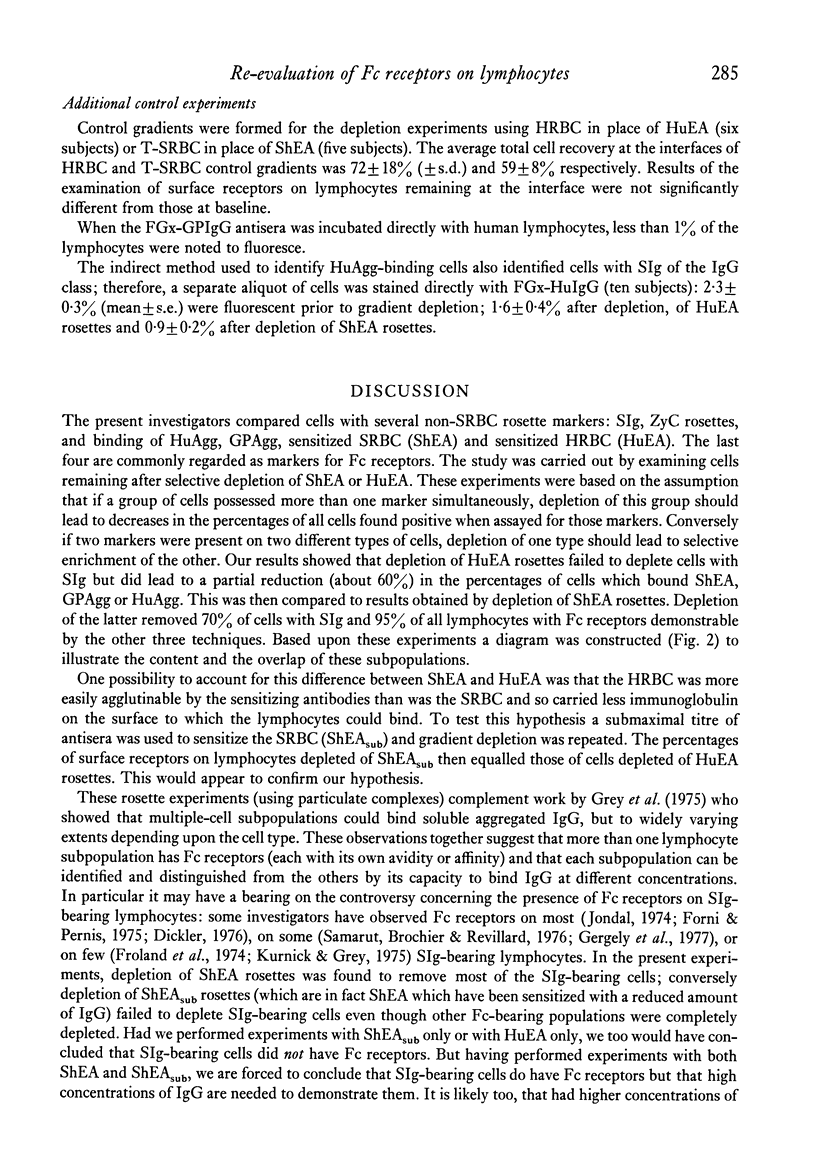Abstract
This study examines whether receptors for IgG (Fc receptors), as identified by different methods, are found on identical human lymphocyte subpopulations, and the relationship of Fc receptors to surface immunoglobulin (SIg) and receptor for complement (C'). Fc receptors were identified by two rosetting techniques (antibody-sensitized human erythrocytes, HuEA, or sheep erythrocytes, ShEA) and two immunofluorescent techniques (heat-aggregated IgG of human origin, HuAgg, or of guinea-pig origin, GPAgg).
When lymphocytes depleted of cells rosetting with ShEA were compared to HuEA-depleted lymphocytes, the two subpopulations appeared to be significantly different. However, when lymphocytes were depleted of cells rosetting with ShEA which had been sensitized with lower concentrations of antibody, the subpopulation so depleted appeared to be virtually identical to HuEA-depleted lymphocytes. These studies suggest that more than one lymphocyte subpopulation has Fc receptors and that each subpopulation can, in part, be identified and distinguished from the other by the capacity to bind IgG at differing concentrations.
In particular, these experiments may serve to resolve the controversy concerning the presence of Fc receptors on lymphocytes bearing surface immunoglobulin (SIg). Depletion of lymphocytes rosetting with ShEA removed most of the SIg-bearing lymphocytes; depletion of cells rosetting with ShEA which had been sensitized with lower concentrations of IgG antibody, however, failed to deplete SIg-bearing lymphocytes even though other Fc-bearing populations were completely depleted. These results suggest that SIg-bearing lymphocytes (B lymphocytes) do have Fc receptors but that high concentrations of IgG are needed to demonstrate them.
Full text
PDF






Selected References
These references are in PubMed. This may not be the complete list of references from this article.
- CLARK H. F., SHEPARD C. C. A DIALYSIS TECHNIQUE FOR PREPARING FLUORESCENT ANTIBODY. Virology. 1963 Aug;20:642–644. doi: 10.1016/0042-6822(63)90292-7. [DOI] [PubMed] [Google Scholar]
- Dickler H. B. Studies of the human lymphocyte receptor for heat-aggregated or antigen-complexed immunoglobulin. J Exp Med. 1974 Aug 1;140(2):508–522. doi: 10.1084/jem.140.2.508. [DOI] [PMC free article] [PubMed] [Google Scholar]
- Froland S. S., Wisloff F., Michaelsen T. E. Human lymphocytes with receptors for IgG. A population of cells distinct from T- and B-lymphocytes. Int Arch Allergy Appl Immunol. 1974;47(1):124–138. doi: 10.1159/000231207. [DOI] [PubMed] [Google Scholar]
- Gergely P., Bakács T., Cornain S., Klein E. Fc receptors on human blood B lymphocytes. Clin Exp Immunol. 1977 Apr;28(1):99–102. [PMC free article] [PubMed] [Google Scholar]
- Horwitz D. A., Lobo P. I. Characterizaiton of two populations of human lymphocytes bearing easily detectable surface immunoglobulin. J Clin Invest. 1975 Dec;56(6):1464–1472. doi: 10.1172/JCI108227. [DOI] [PMC free article] [PubMed] [Google Scholar]
- Jondal M. Surface markers on human B and T lymphocytes. IV. Distribution of surface markers on resting and blast-transformed lymphocytes. Scand J Immunol. 1974;3(6):739–747. doi: 10.1111/j.1365-3083.1974.tb01309.x. [DOI] [PubMed] [Google Scholar]
- Kurnick J. T., Grey H. M. Relationship between immunoglobulin-bearing lymphocytes and cells reactive with sensitized human erythrocytes. J Immunol. 1975 Jul;115(1):305–307. [PubMed] [Google Scholar]
- Samarut C., Brochier J., Revillard J. P. Distribution of cells binding erythrocyte-antibody (EA) complexes in human lymphoid populations. Scand J Immunol. 1976;5(3):221–231. doi: 10.1111/j.1365-3083.1976.tb00273.x. [DOI] [PubMed] [Google Scholar]
- Yu D. T., Clements P. J. Human lymphocyte subpopulations effect of epinephrine. Clin Exp Immunol. 1976 Sep;25(3):472–479. [PMC free article] [PubMed] [Google Scholar]
- Yu D. T., Ramer S. J., Kacena A. Effect of corticosteroids on the response of lymphocytes to stimulation by galactose oxidase-modified lymphocytes. Immunology. 1977 Aug;33(2):247–252. [PMC free article] [PubMed] [Google Scholar]
- Zighelboim J., Gale R. P., Chiu A., Bonavida B., Ossorio R. C., Fahey J. L. Antibody dependent cellular cytotoxicity: cytotoxicity mediated by non t-lymphocytes. Clin Immunol Immunopathol. 1974 Nov;3(2):193–200. doi: 10.1016/0090-1229(74)90005-1. [DOI] [PubMed] [Google Scholar]


